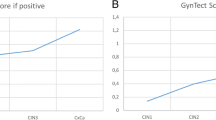Abstracts
Objectives
DNA methylation of paired box-1 (PAX-1) gene has been shown to be a potential biomarker for the detection of high-grade cervical intra-epithelial neoplasia (CIN) and invasive cervical cancer. The objective of this pilot study was to quantify and compare methylation percentage of PAX1 gene in benign cervical lesion, pre-invasive and invasive cervical cancer.
Methods
A total of 200 screen positive women (VIA, VILI and Pap test) underwent colposcopy. Cervical scrapes taken were taken and stored for DNA analysis and PAX 1 methylation status. Women with Swede score of 5 or more (n = 98) were biopsied. Cervical scrapes and biopsy were taken from women with obvious cervical growth (n = 14), without prior colposcopy. Sixty women were recruited to the study and allocated into three groups on the basis of histopathology, i.e., benign cervix (Group 1; n = 20), CIN 2/3 (Group 2; n = 20) and invasive cervical carcinoma (Group; n = 20). PAX 1 methylation percentage was calculated from the DNA extracted from the cervical scrapes of the women recruited.
Results
The mean PAX1 methylation percentage in benign lesions, CIN 2/3 and invasive cancer was 9.58% (SD ± 2.37%), 18.21% (SD ± 2.67%) and 24.34% (SD ± 4.09%), respectively, with p-value of < 0.001.
Conclusions
PAX 1 gene methylation has a promising role in identifying high-grade lesions and invasive cancer.



Similar content being viewed by others
References
World Health Organization (WHO). Cervical Cancer Estimated Incidence, Mortality and Prevalence Worldwide in 2018. https://www.uicc.org/new-global-cancer-data-globocan-2018. Accessed on 25th jan. 2022.
Snijders PJ, Steenbergen RD, Heideman DA, Meijer CJ. HPV-mediated cervical carcinogenesis: concepts and clinical implications. J Pathol. 2006;208:152–64.
McCredie MR, et al. Natural history of cervical neoplasia and risk of invasive cancer in women with cervical intraepithelial neoplasia 3: a retrospective cohort study. Lancet Oncol. 2008;9:425–34.
Vink MA, Bogaards JA, van Kemenade FJ, de Melker HE, Meijer CJ, Berkhof J. Clinical progression of high-grade cervical intraepithelial neoplasia: estimating the time to preclinical cervical cancer from doubly censored national registry data. Am J Epidemiol. 2013;178:1161–9.
Steenburgen RD, Snijders PJ, Heideman DA, Meijer CJ. Clinical implications of (epi)genetic changes in HPV-induced cervical precancerous lesions. Nat Rev Cancer. 2014;14(6):395–405.
Shen H, Laird PW. Interplay between the cancer genome and epigenome. Cell. 2013;153(1):38–55.
Lai HC, Lin YW, Huang TH, Yan P, Huang RL, Wang HC, et al. Identification of novel DNA methylation markers in cervical cancer. Int J Cancer. 2008;123:161–7.
Eijsink JJ, Yang N, Lendvai A, Klip HG, Volders HH, Buikema HJ, et al. Detection of cervical neoplasia by DNA methylation analysis in cervico-vaginal lavages, a feasibility study. Gynecol Oncol. 2011;120(2):280–3.
Overmeer RM, Louwers JA, Meijer CJ, van Kemenade FJ, Hesselink AT, Daalmeijer NF, et al. Combined CADM1 and MAL promoter methylation analysis to detect (pre-) malignant cervical lesions in high-risk HPV-positive women. Int J Cancer. 2011;129(9):2218–25.
Su PH, Lai HC, Huang RL, et al. Paired box-1 (Pax1) activates multiple phosphatases and inhibits kinase cascades in cervical cancer. Sci Rep. 2019;9(1):9195.
Xu J, Xu L, Yang B, Wang L, Lin X, Tu H. Assessing methylation status of PAX1 in cervical scrapings, as a novel diagnostic and predictive biomarker, was closely related to screen cervical cancer. Int J Clin Exp Pathol. 2015;8(2):1674–81.
Bowring J, Strander B, Young M, Evans H, Walker P. The swede score: evaluation of a scoring system designed to improve the predictive value of colposcopy. J Low Genit Tract Dis. 2010;14(4):301–5.
Huang TH, Lai HC, Liu HW, Lin CJ, Wang KH, Ding DC, et al. Quantitative analysis of methylation status of the PAX1 gene for detection of cervical cancer. Int J Gynecol Cancer. 2010;20(4):513–9.
Xu L, Xu J, Hu Z, et al. Quantitative DNA methylation analysis of paired box gene 1 and LIM homeobox transcription factor 1 α genes in cervical cancer. Oncol Lett. 2018;15(4):4477–84.
Kelly H, Benavente Y, Pavon MA, De Sanjose S, Mayaud P, Lorincz AT. Performance of DNA methylation assays for detection of high-grade cervical intraepithelial neoplasia (Cin2+): a systematic review and meta-analysis. Br J Cancer. 2019;121(11):954–65.
Acknowledgements
This study was funded by Indian Council of Medical Research
Funding
The study was funded by Indian Council of Medical Research.
Author information
Authors and Affiliations
Corresponding author
Ethics declarations
Conflict of interest
No conflict of interest among the authors.
Ethical approval
Study has been approved by institutional ethics board and all procedures performed in study involving human participants were in accordance with the ethical standards of the institution and with the 1964 Helsinki declaration and its later amendments or comparable ethical standards.
Informed consent
Informed consent was obtained from all the participants included in the study.
Consent for publication
The work described has not been published before and is not under consideration for publication anywhere else. The publication has been approved by all co-authors at the institute where the work has been carried out.
Additional information
Publisher's Note
Springer Nature remains neutral with regard to jurisdictional claims in published maps and institutional affiliations.
Dr Bhavya (MS) is a Senior Resident, Department of Obstetrics & Gynecology at UCMS & GTB hospital, Delhi, India; Shalini Rajaram (MD) is a Professor, Division of Gynecologic Oncology, AIIMS, Rishikesh, India; Bindiya Gupta (MD) is an Associate Professor, Department of Obstetrics & Gynecology at UCMS & GTB hospital, Delhi, India; B.D. Banerjee (MD) is a Professor, Department of Biochemistry, UCMS & GTB Hospital, Delhi, India; Vinod Kumar Arora (MD) is a Director Professor, Department of Pathology, UCMS & GTB Hospital, Delhi, India; Gaurav Thakur (Msc) is a Ph.D. Scholar, Department of Biochemistry, UCMS & GTB Hospital, Delhi, India; Sandhya Jain (MD) is an Associate Professor, Department of Obstetrics & Gynecology at UCMS & GTB hospital, Delhi, India.
Rights and permissions
About this article
Cite this article
Bhavya, Rajaram, S., Gupta, B. et al. PAX1 Methylation Status in Cervical Scrapes as Novel Diagnostic Biomarker in CIN 2/3 and Invasive Squamous Cell Carcinoma. J Obstet Gynecol India 72, 522–528 (2022). https://doi.org/10.1007/s13224-022-01680-5
Received:
Accepted:
Published:
Issue Date:
DOI: https://doi.org/10.1007/s13224-022-01680-5




